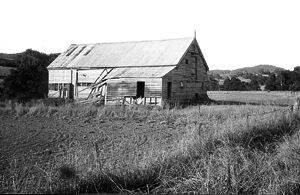
GRAZIER Mr Fred Whitby of Rocky Hall has farm buildings that have experienced and endured the strong winds that can strike the region during October for many years.
Subscribe now for unlimited access.
or signup to continue reading
One of the historic buildings on his property, however, could not.
The old Rocky Hall Butter Factory, used for many years as a hayshed, succumbed to wild weather and was reduced to a collapsed pile of timber beneath a roof in the last high winds to hit the Towamba river flats on which the building stood.
"There must have been an exceptionally strong gust," Mr Whitby said.
"Although some of the timbers had deteriorated on the lean-to on the upstream side, most of the timbers were as solid as the day they were put there.
The old building seemed pretty sturdy."
Mr Whitby said that when he went down to his mailbox at 5.30pm on October 28 the mailman, who had just driven up the road, told him that the building had come down.
The butter factory stood as a landmark to people travelling through Rocky Hall for years; even visitors passing through on their way to and from the Monaro via the South East National Park would comment on the building and stop to take photographs.
It was constructed by the Rocky Hall Dairy Company in 1896 and operated for 30 years.
Cream from the dairy farms of Rocky Hall then went to the Pambula factory until that, too, closed.
Mr Whitby said it was one of the oldest dairy co-operatives in NSW, older even than the Bega Dairy Co-operative.
Mr Whitby still has ledgers from the factory in his care, along with many old photographs that date from a time when Rocky Hall was a thriving village.
The ledgers date from 1896 and record deliveries and payments to the dairy farmers who supplied cream to the factory.
Names that are synonymous with Rocky Hall, Wyndham, Burragate and their outlying regions include Whitby, Grant, Kerr, Robertson, Rixon, Sherwin, Ryan, Underhill, Collins, Knightly, Travers and the Elphick brothers.
Regular Cathcart suppliers included Crotty, Stewart, Mawson, O'Reilly, Griffiths and Baker.
However, in 1918 the factory that most Cathcart suppliers sent their butter to must have closed temporarily, because there was a sudden influx of suppliers from the Monaro.
They included Gerathy, Vernon, Murphy, McMahon, Maddern, Stove, Solomon, Kimber, Ingram, Gaunson, Overend and many more names that are well-known throughout the region.
During the month of November, when the numbers of suppliers was swelled by the Cathcart influx, two amounts of butter produced are recorded; 15,903 and 32,425 lbs of butter.
While the factory was not among the region's biggest, it was among the best.
Mr Whitby says butter produced at Rocky Hall was sent to London and took prizes there.
A letter slipped into the pages of one 1918 ledger from Foley Bros, Australian Merchants based in Sydney, states:
"We have the pleasure to hand you herewith account sales for 80 boxes of butter which we had stored on your account and have forwarded cheque for the profit - 43 pounds 14 shillings to your bank as usual and we trust this will meet with your approval.
"You will see that for the butter we sold in Melbourne we secure 150/- and 160/- per cent and we feel convinced that no other factory in your district has done better than you have with their government butter.
"Trusting to have larger consignments from you and thanking you in anticipation, etc."
However, times were changing.
A big drought hit in 1923 and the Whitby family, backbone of the Rocky Hall dairy industry, stopped supplying the factory.
"The factory was under severe stress from then on," Mr Whitby said.
"By 1924 the motor lorry transport had progressed and farmers could send their cream to Pambula."
A paragraph from the Bombala Times in 1924 states that the Rocky Hall Dairy Company building, plant and machinery were for sale.
The building continued to provide cover for large quantities of hay, invaluable to the farmers in times of drought.
The fact that the recent drought resulted in lower stocks of hay than usual inside the building has been put forward as a reason that it was less able to withstand strong winds.
It stood as a link to the times when Rocky Hall boasted a general store, pub, post office and church as well as the school, hall and butter factory.
Now that link with the past is gone, and only the school (now a pre-school and community centre) and hall remain to indicate the village that Rocky Hall once was.
The Rocky Hall community is indebted to Mr Whitby, whose knowledge of the area is extensive, for keeping the history of a bygone time alive.

